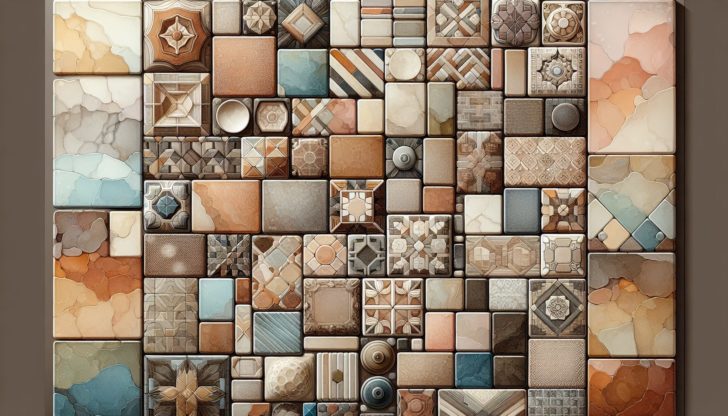In the porcelain vs ceramic debate for home tiles, practical considerations take center stage. Whether it’s durability, cost efficiency, or ease of maintenance you’re seeking, understanding the distinctions is crucial. This guide cuts through the noise to help you decide which tiling is best-suited for your living spaces without compromising on style or function.
Table of Contents
Key Takeaways
Porcelain tiles are made from refined clay and fired at high temperatures, resulting in greater density and lower porosity compared to the softer and less dense ceramic tiles, which affects their moisture resistance, durability, maintenance needs, and cost.
Porcelain’s low porosity and high density make it ideal for high-traffic and moisture-prone areas due to its superior durability and water resistance, while ceramic tiles offer a warm aesthetic and are more suited to quieter spaces with lighter use.
Both porcelain and ceramic tiles are low maintenance, but porcelain may require less frequent repairs or replacement due to its durability, contributing to potentially higher long-term value despite its higher initial cost and installation expenses.
Porcelain vs Ceramic: Unveiling the Core Differences

When it comes to tiling, each choice you make is a layer in the foundation of your home’s aesthetic and functional longevity. Porcelain and ceramic tiles, two popular options in the world of flooring, come with their unique set of attributes. At first glance, they might look quite similar, but a closer inspection reveals a world of difference, affecting everything from:
resistance to moisture
durability
ease of maintenance
cost
design options
Understanding these differences will help you make an informed decision when choosing between porcelain and ceramic tiles for your home.
Understanding these differences is key to making an informed decision that aligns with your home’s needs and your personal style.
Composition and Creation
Peering at the core, the composition of porcelain and ceramic tiles sets the stage for their distinct performance. Ceramic tiles are crafted from a blend of natural clays, usually red or brown, shaped and then fired at lower temperatures, resulting in a softer tile. Porcelain tiles, on the other hand, are born of a refined white clay mixed with minerals such as Feldspar and sand and are fired at much higher temperatures. This intense heat produces a denser, less porous tile, which translates into a stronger and more durable surface.
Porosity and Density
The porosity and density of a tile are not just technical terms; they are practical indicators of how a tile will behave in your home. Porcelain tiles tend to have a water absorption rate of less than 0.5%, landing them in the impervious category according to the Tile Council of North America standards. This low porosity means they are an ally against moisture, making them ideal for bathrooms and kitchens where spills and splashes are part of daily life.
The high density also makes porcelain tiles highly resistant to extreme temperatures and less likely to fade over time, ensuring their beauty endures as long as their functionality.
Appearance and Finish
Moving beyond the technical, the appearance and finish of a tile often seal the deal. Porcelain’s versatility shines through its ability to mimic luxurious materials like marble or wood, offering a high-end look without breaking the bank. Its low porosity doesn’t hinder its finish options; whether glazed for a touch of color and texture or left unglazed for a through-body color, porcelain tiles deliver on design flexibility.
Ceramic tiles, often used for ceramic flooring, provide a warm and earthy touch with their natural clay hues. The finishes range from glossy to matte, each bringing a different energy to a space.
The Durability Debate: Porcelain vs Ceramic Tiles

A tile floor is a long-term relationship; it’s a commitment to a material that will face daily wear, furniture rearrangements, and the occasional dropped object. It’s crucial, then, to consider the durability of your tile choice.
Porcelain and ceramic tiles may share a lineage, but when it comes to standing the test of time, they diverge. Porcelain’s inherent robustness makes it a contender for areas in your home that will see a lot of life, while ceramic’s cozier feel suits it to spaces that cradle quieter moments.
Resistance to Wear and Tear
The resistance to wear and tear of porcelain tiles is not just a claim; it’s baked into their very substance. Crafted from a dense material, porcelain stands up to abrasion like a seasoned warrior, shrugging off the scuffs and scratches that daily activities may bring. Its composition and the high-temperature firing process result in a tile that’s tougher and less likely to chip or crack than its ceramic cousins.
And while ceramic tiles may show their battle scars more readily, with chips revealing their natural clay beneath the glaze, porcelain’s uniform color can keep minor damages discreet.
Check out Advantages and disadvantages of porcelain tiles.
Suitability for High Traffic Zones
In the hustle and bustle of high traffic areas, a tile’s mettle is truly tested. Porcelain’s density and hardness make it the champion of heavy foot traffic, capable of enduring the constant march of life without showing signs of surrender. Its reliability and resistance to damage make it the go-to flooring for spaces that see a lot of action, from bustling family kitchens to commercial corridors.
Even in the face of wear, porcelain maintains its elegance, blending durability with a sophistication that serves both its purpose and aesthetic appeal.
Impact on Longevity
The longevity of your tile flooring isn’t just about enduring the years; it’s about preserving its looks and functionality throughout its lifecycle. Porcelain tiles, known as a durable tile option, with their exceptional durability, are often a better long-term investment, especially in high-traffic areas where their resistance to cracking and chipping shines.
Proper installation and substrate preparation further contribute to the lifespan of porcelain tiles, preventing issues that could prematurely age your flooring. When considering the future of your floors, porcelain can offer a lasting foundation that continues to deliver:
Beauty
Performance
Durability
Longevity
year after year.
Maintenance Matters: Caring for Your Tile Flooring
The true cost of flooring goes beyond the price tag; it includes the time and effort of maintenance. Both porcelain and ceramic tiles offer the gift of low maintenance, but even the toughest tiles need a little tender loving care. Understanding the nuances of cleaning, sealing, and potential repairs will help you keep your floors looking as stunning as the day they were laid, ensuring that your investment continues to pay dividends in both looks and longevity.
Cleaning Ceramic and Porcelain Surfaces
When it comes to cleaning ceramic and porcelain surfaces, simplicity is the secret. Regular upkeep, which includes gentle sweeping, vacuuming, and mopping, can keep porcelain tiles looking pristine and prevent surface wear or scratches. Ceramic floors welcome a slightly different approach, one that involves a concoction of warm water, white vinegar, and dish soap to cleanse and renew their surfaces, followed by a clear water rinse and a soft cloth to dry.
Regardless of the tile type, avoiding harsh chemicals, abrasive tools, and finely ground sand is a rule of thumb to maintain the integrity of your flooring.
Sealing and Protection
While porcelain and ceramic tiles are celebrated for their low maintenance, the question of sealing and protection does come up, especially in the context of preserving their beauty over time. Typically, neither porcelain nor ceramic tiles require sealing thanks to their inherent durability. However, the grout and sealant quality can enhance the protective capabilities and longevity of porcelain tiles, complementing their already minimal maintenance needs due to lower porosity.
For ceramic tiles, a sealer can add a shine and help prevent stains and damage, potentially easing the path of future cleaning efforts.
Repair and Replacement Considerations
Even with diligent care, life can throw unexpected curveballs that leave your tiles in need of repair or replacement. It’s worth noting that the cost to replace a porcelain tile might be higher than that of ceramic due to its higher base price. However, considering the durability and longevity of porcelain, replacements may occur less frequently, offsetting the initial expense over time.
Opting for either type of tile, routine maintenance can mitigate the need for repairs, ensuring that your floors continue to serve as a durable canvas for your daily life.
Cost Comparison: Budgeting for Porcelain and Ceramic Tiles
When it comes to home renovation, the budget often steers the ship, and flooring is no exception. Between porcelain and ceramic tiles, there’s a spectrum of costs that can sway your decision. It’s not just about the upfront price per square foot; factors like installation, labor, and long-term value all play crucial roles in your investment.
Let’s navigate the financial waters of choosing the right tile without compromising on quality or aesthetic.
Per Square Foot Pricing
The price per square foot can often dictate the direction of your tiling project. Ceramic tiles offer a wallet-friendly starting point, with costs ranging widely before installation, from the humble $1 to the loftier $30, with an average hovering around $15.50 per square foot.
Porcelain tiles command a higher price due to their superior durability and lower porosity, ranging from $3 to an indulgent $30 per square foot, averaging at $16.50, not yet including installation.
Installation and Labor Costs
While the sticker price of tiles is one thing, the installation and labor costs can paint a whole different financial picture. Porcelain’s density and toughness make it more challenging to cut and lay, often requiring specialized tools and expertise. This can drive up professional installation costs, averaging from $6 to $13 per square foot, and potentially as high as $44 for complex projects.
Ceramic tiles are simpler to handle and install, reflecting in their more modest labor costs, which average $5 to $12 per square foot. When planning your budget, remember to factor in these costs to avoid any surprises.
Value Over Time
When considering the long-term value of your flooring, it’s important to look beyond the initial investment. Repair costs for porcelain and ceramic tiles tend to be more affordable than those for natural stone, with expenses ranging from $0.50 to $15 per square foot. Grout repair can also add to the overall costs but is generally manageable, with total expenses potentially reaching between $180 to $450.
Porcelain’s exceptional durability may mean fewer repairs and replacements over time, possibly making it the more cost-effective choice in the long run.
Design Dynamics: Aesthetic Choices in Porcelain and Ceramic
The beauty of porcelain and ceramic tiles lies not just in their practical benefits but also in their transformative power to elevate the aesthetics of any space. As an essential element of interior design, the choice between porcelain and ceramic can influence the ambiance of your rooms.
With a myriad of design options at your fingertips, let’s explore how these materials can cater to your personal taste and complement the interior design of your home.
From Natural Stone to Modern Matte
Porcelain and ceramic tiles, including floor tiles, serve as a canvas for your creativity, offering finishes that range from the rustic charm of natural stone to the contemporary allure of modern matte. Porcelain tiles, in particular, can mimic the opulent textures of marble, granite, and even wood, providing the grandeur of these materials without their hefty price tags and maintenance requirements.
Ceramic tiles, with their glazes and painted patterns, allow for a personalized touch that can bring warmth and character to any room. Whether your style leans towards the timeless elegance of stone or the sleek sophistication of a ceramic tile matte finish, there’s a tile to match your vision.
Color Consistency and Variation
A harmonious color palette can be the difference between a house and a home. Porcelain tiles are celebrated for their color consistency, offering a seamless look across your floors or walls, making them ideal for those who appreciate a uniform design.
Ceramic tiles present a kaleidoscope of colors, inviting a play of shades and tones that can add depth and richness to your space. Whether you’re looking to create a cohesive flow or a vibrant mosaic of hues, the choice between porcelain and ceramic can guide your artistic endeavor.
Textures and Sizes
The texture and size of tiles can have a profound impact on the perception of your space. Porcelain and ceramic tiles come in an array of textures, like the reflective sheen of glossy finishes or the understated elegance of matte and honed surfaces. The choice of texture not only contributes to the aesthetic but also to the functionality, with certain finishes offering slip resistance, an important consideration for areas like bathrooms and kitchens.
Size plays a similar role, where larger tiles can make a small room feel more expansive while smaller tiles can add intricacy and detail to a space.
Environmental Adaptability: Where to Install Porcelain and Ceramic Tiles
Where you choose to lay your tiles can have as much impact as the tiles themselves. Porcelain and ceramic tiles, while both versatile, have their particular strengths when it comes to environmental adaptability. Porcelain, with its robustness and low water absorption, is a natural fit for both the great outdoors and the humidity of indoor spaces. Ceramic, with its decorative appeal, shines in less exposed environments.
Understanding how these materials respond to different conditions will ensure that your tile selection not only looks good but also performs optimally wherever it is installed.
Water Resistant Wonders for Bathrooms and Kitchens
Bathrooms and kitchens are battlegrounds for moisture, and the bathroom flooring you choose needs to be up for the challenge. Porcelain tiles, with their impressively low water absorption rate, act as a shield against moisture, ensuring that the spaces remain hygienic and damage-free. Despite their resistance, porcelain tiles still benefit from waterproofing measures in humid conditions, safeguarding their integrity in the long term.
Ceramic tiles, while not as moisture-friendly as porcelain, can still perform well in lower moisture zones or when used as wall tiles, provided they are properly maintained. For floors that encounter frequent water, such as shower areas, matte finish porcelain tiles offer the added benefit of slip resistance, marrying safety with water resistance.
Embracing the Elements: Outdoor Use and UV Resistance
The great outdoors presents a unique set of challenges for flooring, from fluctuating temperatures to unrelenting UV rays. Porcelain tiles rise to this occasion with their exceptional durability and weather-resistant properties, including frost and fade resistance, making them an ideal choice for patios, decks, and outdoor walkways. When choosing tiles for outdoor use, it’s important to opt for those that are specifically designed to handle the elements, ensuring that they remain beautiful and functional throughout the seasons.
Porcelain’s ability to withstand temperature changes without cracking and its minimal expansion and contraction make it a reliable option for an environment where the only constant is change. This is why the Porcelain Enamel Institute is dedicated to researching and promoting the use of this versatile material.
Decorative Flair: Using Ceramic for Accent Walls
While porcelain is the stalwart of durability, ceramic tiles offer a playground for visual creativity, especially when it comes to accent walls. With their wide range of glazes, colors, and patterns, ceramic tiles can transform a plain wall into a statement piece, adding depth and character to any room. Handmade options and unique designs allow for individual expression and a bespoke feel that can’t be replicated.
Additionally, opting for ceramic tiles on accent walls can lead to cost savings, particularly in areas that don’t face the wear and tear of foot traffic or the harshness of outdoor conditions. Moreover, the sustainable practices often employed in the manufacturing of ceramic tiles add an environmentally conscious aspect to their decorative appeal.
Summary
In the grand mosaic of home renovation, the choice between porcelain and ceramic tiles is a significant one. Porcelain, with its high density, low porosity, and exceptional durability, offers a sturdy, long-lasting choice for areas that see heavy use or exposure to the elements. Ceramic tiles, while not as robust as porcelain, provide a cost-effective and aesthetically versatile option for indoor use and areas with less foot traffic. By considering factors like environmental adaptability, maintenance, cost, and design, homeowners can make an educated decision that balances practicality with personal style. Let the tiles you choose be the foundation upon which your home’s character and comfort are built.
Frequently Asked Questions
What are the main differences between porcelain and ceramic tiles?
Porcelain tiles are denser, less porous, and more durable than ceramic tiles due to their composition and firing process. Ceramic tiles, made from natural clays, are softer and more porous than porcelain tiles.
Can ceramic tiles be used in high moisture areas like bathrooms?
While ceramic tiles can be used in bathrooms, it’s generally recommended to use porcelain tiles for better resistance to moisture. If you do choose ceramic tiles, make sure to maintain and seal them properly to protect against moisture.
Is it necessary to seal porcelain and ceramic tiles?
Sealing porcelain and ceramic tiles is generally not necessary due to their durability. However, it is important to seal the grout between the tiles to prevent staining and moisture penetration, particularly in areas with water exposure.
Are porcelain tiles suitable for outdoor use?
Yes, porcelain tiles are suitable for outdoor use due to their high density, low water absorption rate, resistance to frost and UV rays, and ability to withstand temperature fluctuations without cracking. Therefore, they make an excellent choice for outdoor spaces.
How does the cost of porcelain tiles compare to ceramic tiles?
Porcelain tiles are typically pricier than ceramic tiles, with prices ranging from $3 to $30 per square foot compared to ceramic tiles, which range from $1 to $30 per square foot. However, porcelain’s durability and low maintenance could offer better long-term value.









